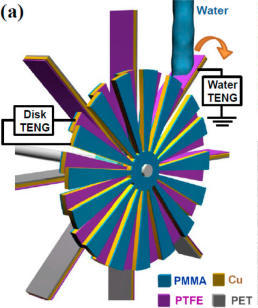Inventors at Georgia Tech have developed a triboelectric nanogenerator (TENG) that can simultaneously harvest both mechanical and electrical energies from flowing water. Shaped like a water wheel, the TENG has wheel blades coated with thin, superhydrophobic films that collect electrostatic energy from flowing water. The device also collects mechanical kinetic energy as flowing water impacts and rotates the wheel. These two aspects of this technology are called water-TENG and disk-TENG, respectively, and together they form a hybridized, dual-mode TENG that can reliably generate a large power output.
In addition, the TENG also acts as a self-powered sensor to detect the rate of flowing water as well as wind speed and ethanol concentration. This technology could serve as an innovative solution for sustainably harvesting mechanical energy from the environment and could one day be integrated with a major power grid.
- Sustainable: Harvests energy from the environment to minimize the use of non-renewable materials for power
- Highly efficient: Exhibits an unprecedented conversion efficiency of 50% to 85%, an area power density of 313 watts per square meter, and a volume power density of 340 kilowatts per cubic meter
- Powerful: Integrates with several other TENGs for output power of 1 megawatt
- Remote sensors
- Self-powered electronic devices
- Self-powered nanosensors
- Power consumption reduction in power systems
Interest in technologies that can harvest renewable energy from the environment is increasing and, while Georgia Tech has developed several applications for the TENG, this variation can be used in wet conditions and utilizes contact electrification with sources other than solid materials. Innovations like this hybridized TENG are particularly desirable in remote locations where power sources may be sparse or for agencies looking to save costs by reducing the power consumption of their systems. Such a technology would also be highly useful across industries that require remote sensing applications, including military/aerospace, wireless networks, energy and utilities, environmental monitoring, oceanography, manufacturing, automotive and aerospace electronics, and even for medical devices.

This hybridized TENG includes disk-TENG and water-TENG to harvest both aspects of mechanical energy. The TENG’s material components include poly(methyl methacrylate)
